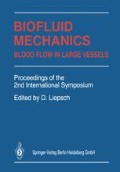Abstract
Hemodynamic forces associated with blood flow provide an important potential influence on both the physiology and pathophysiology of the cardiovascular system. As the lining of the entire cardiovascular system, the endothelium is uniquely positioned to be the sensor, responder, and transducer of these hemodynamic signals. A major component of the hemodynamic forces which impact upon the vascular endothelium is fluid-imposed wall shear stress. Since the magnitude of this shear stress is dependent upon both the velocity of blood flow across the endothelial surface as well as the geometry of the vascular bed, the shear stress magnitude experience by endothelium varies greatly even within a specific vascular segment. For example, the endothelium residing within the branch points of the abdominal aorta experience much different wall shear stress levels than endothelium residing in straight channels of the same vessel. It is this diversity of shear stress and its correlation with focal differences in arterial physiology and pathology, that has led to the hypothesis that hemodynamic shear stress may modulate the physiology of the vascular wall as well as play a key role in the pathogenesis of diseases such as atherosclerosis.
Access this chapter
Tax calculation will be finalised at checkout
Purchases are for personal use only
Preview
Unable to display preview. Download preview PDF.
References
Nerem RM, Levesque MJ, Cornhill JF: Vascular endothelial morphology as an indicator of patterns of blood flow. J Biomech Eng 103: 172–176, 1981.
Schwartz CJ, Gerrity RG, Lewis LF: Arterial endothelial structure and function with particular reference to permeability; in R Paoletti and AM Gotto (Eds): Atherosclerosis Reviews, New York, Raven Press Vol 3 pp. 109–124, 1978.
Dewey CF, Bussolari SR, Gimbrone MA Jr, Davies PF: The dynamic response of vascular endothelial cells to fluid shear stress. J Biomech Eng 103: 177–185, 1981.
Sprague EA, Steinbach BL, Nerem RM, Schwart CJ: Influence of a laminar steady state fluid-imd wall shear stress on the binding, internalization and degradation of low density lipoproteins (LDL) by cultured arterial endothelium. Circ 76: 648–657, 1987.
Frangos JA, Eskin SG, McIntire LV, Ives CL: Flow effects on prostacyclin production by cultured human endothelial cells. Science 227: 1477–1479, 1985.
Diamond SL, Eskin SG, McIntire LV: Fluid flow stimulates tissue plasminogen activator secretion by cultured human endothelial cells. Science 243: 1483–1485, 1989.
Sato M, Levesque MJ, Nerem RM: Micropipette aspiration of cultured bovine aortic endothelial cells exposed to shear stress. Arteriosclerosis 7: 276–286, 1987.
Goldstein JL, Basu SK, Brown MS: Receptor mediated endocytosis of low density lipoprotein in cultured cells, in Fleischer S, Fleischer B (Eds), Methods in Enzymology, Acad Press, Inc. vol 98, pp 241–2600, 1983.
Berridge MJ: Rapid accumulation of inositol triphosphate reveals that agonists hydrolyze polyphosphoinositides instead of phosphatidyl inositol. Biochem J 212: 849–858, 1983.
Janmey PA, Stossel TP: Gelsolin-polyphosphoinositide interaction. J Biol Chem 264: 4825–4831, 1989.
Olesen SP, Clapham DE, Davies PF: Haemodynamic shear stress activates a K+ current in vascular endothelial cells. Nature 331: 168–170, 1988.
Bhagyalakshmi A, Frangos JA: Mechanism of shear-induced prostacyclin production in endothelial cells. Biochem Biophys Res Comm 158: 31–37, 1989.
Author information
Authors and Affiliations
Editor information
Editors and Affiliations
Rights and permissions
Copyright information
© 1990 Springer-Verlag Berlin Heidelberg
About this paper
Cite this paper
Sprague, E.A., Nerem, R.M., Schwartz, C.J. (1990). Cellular Recognition and Transduction of Fluid Mechanical Shear Stress Signals. In: Liepsch, D.W. (eds) Biofluid Mechanics. Springer, Berlin, Heidelberg. https://doi.org/10.1007/978-3-642-52338-0_23
Download citation
DOI: https://doi.org/10.1007/978-3-642-52338-0_23
Publisher Name: Springer, Berlin, Heidelberg
Print ISBN: 978-3-540-52730-5
Online ISBN: 978-3-642-52338-0
eBook Packages: Springer Book Archive

